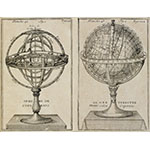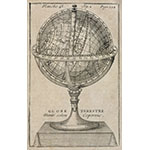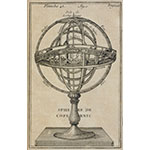Sphere representing the surface of the Earth (terrestrial globe) or the celestial vault (celestial globe).
The terrestrial globe is the representation of the Earth on a spherical surface, generally drawn or printed on paper, divided into gores, then pasted onto a suitably armed wooden or chalk sphere. The terrestrial globe came into widespread use after the great geographic discoveries that began in the late fifteenth century. Globe-making methods were continuously perfected.
Solid model of the celestial vault, designed for astronomical and astrological calculations, showing the constellations of the so-called "eighth sphere" (carrying the fixed stars) and the circles that describe it: equator, meridian, Tropic of Cancer, Tropic of Capricorn, polar circles, and ecliptic. Already used by the Chaldeans and Egyptians, the celestial globe, made of stone or metal, gave way to more sophisticated representations of the celestial vault, such as the armillary sphere (as early as the Hellenistic period) and the astrolabe (from the 2nd C. C.E.).










